I had gone past Claremont Terrace thousands of times — literally –without giving it a second thought about what it was. It’s an alley that is hidden along another dead end in the heart of Elmhurst, one of Queens’ busiest, most populated and diverse neighborhoods — it’s buzzing with energy day and evening. I would pass it, though, on the Long Island Rail Road on my way from Flushing to Penn Station, since its last remaining mansion, in a decayed, ravaged condition, was visible along the tracks. Claremont Terrace’s origins lie in American immigration, and a young businessman who made his name in the United States in the pre-Civil War era, beginning an enterprise that exists and flourishes today.
Samuel Lord (1803-1889) was a British foundry worker from Yorkshire who came to the USA with dreams of entrepreneurship, opening a drapery-dry goods shop on Catherine Street in what is now the Lower East Side in 1824, and after struggling for over a decade, he sent for his wife and children to join him in the USA. At about the same time his brother-in-law, George Washington Taylor, joined him as a partner and investor.
Lord and Taylor opened a larger store near the docks at Grand and Chrystie Streets in 1854, at a time when Grand was among the city’s busiest shopping streets — it was close to the east side docks along South Street, making importing goods a simple matter. The business became wildly successful, both men were millionaires by the early 1860s, and were then able to retire and return to England. The store moved to 20th Street and Broadway in 1902 and then to 5th Avenue and 38th Street in 1914, where it has continued an over 150-year run of success.
In 1840, while he was still struggling on the Lower East Side, though, Samuel Lord bought property in Newtown — today’s Elmhurst.
Lord purchased a house at today’s Broadway and Elmhurst Avenue in 1840, and opened a country store across the road. He was committed to Newtown — he commuted by ferry to the Lower East Side each day, and evidently liked what was then a small town, acquiring over 100 acres centered around today’s Broadway where it crosses the Port Washington Branch of the Long Island Rail Road.
1891 Newtown map. Broadway is the street that runs from NW to SE, “Flushing Avenue” is today’s Elmhurst Avenue, and Union Avenue is the current Corona Avenue. Note the labels “Lord Est(ate)” on either side of the railroad.
Also notice the semicircle on Broadway, just south of the railroad, and, zooming in, we see its name…”Clermont Terrace”, with four homes arranged along its length…
The Lords raised two sons and four daughters in Newtown. In 1856, Lord built four 2 and a half story mansions for his four daughters along a semicircular path that he named Clermont (later Claremont) Terrace -- it was on a short rise -- on Broadway just south of the new LIRR branch, which was built shortly after the mansions were. The above scenes are a postcard view and a photo of two and three of the mansions respectively. See the house on the left in the picture on the right?
Up until late 2006, it was still there; I photographed it in about 2000 or 2001. By then it had lost its front porch and gained something of an indoor porch, but had been abandoned and deteriorating for many years indeed. I don't know what happened in the intervening years -- anyone remember when someone lived there?
In 2006 construction started on a large multifamily building on Claremont Terrace, but evidently, funding dried up and the house is waiting for more money to flow in. A very small slice of the 1856 mansion remains in the front of the new building. It is pretty much what is left of the Samuel Lord legacy in Queens...but his Manhattan department store -- the first to install an elevator and the first to install a non-sales oriented Christmas window display -- goes on and on. Information from Elmhurst: From Town Seat to Mega-Suburb by Vincent Seyfried and The Historic Shops and Restaurants of New York by Ellen Williams and Steve Radlauer.
These days, the road that once led to 4 magnificent mansions visible from Broadway is hidden behind storefronts and is accessible only from Dongan Avenue, itself a dead end as it runs into the LIRR east of Broadway. Claremont Terrace has not been paved for decades. Dongan Avenue was cut through in the early 1930s, cutting Claremont Terrace in two. The construction of the road helped to eliminate the southern pair of the mansions, with the two northern surviving.
In this view of the area on a 1927 Belcher-Hyde map, the outline of Dongan Avenue is there although it has not yet been built. Oddly, 45th Avenue, which was shown as completed, has disappeared since. We also see the four Claremont Terrace houses represented here: four yellow squares arranged from top to bottom east of Broadway. Notice that the third house is right in the path of Dongan Avenue, and it was razed shortly after 1927. The northernmost, just south of the "45" made it to 2006, its 150th anniversary.
5/7/08

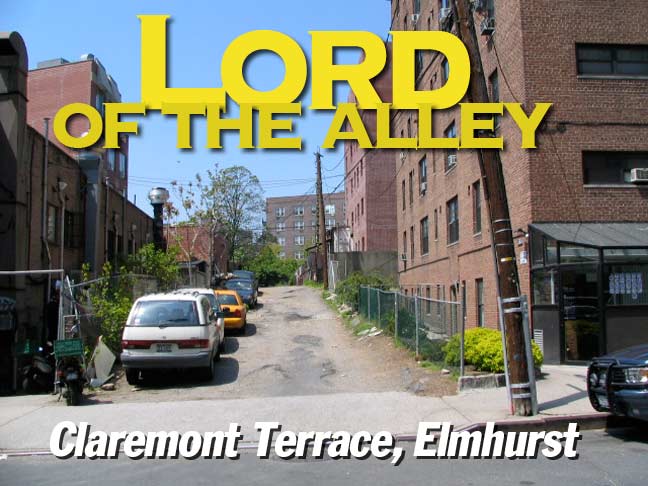
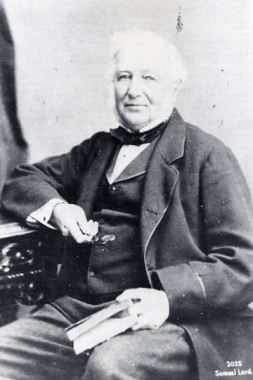

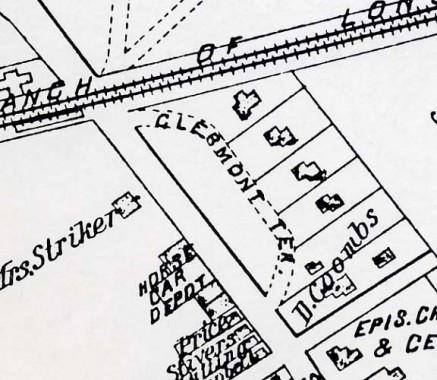
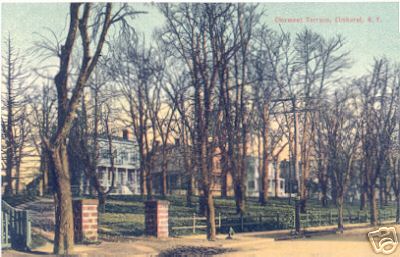
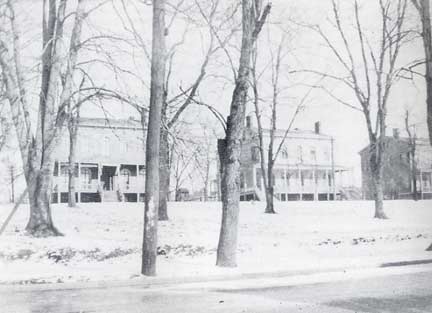
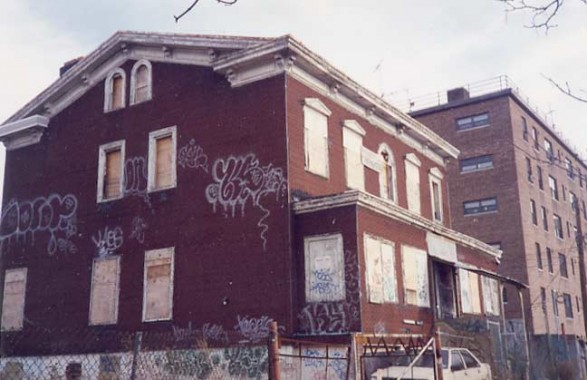

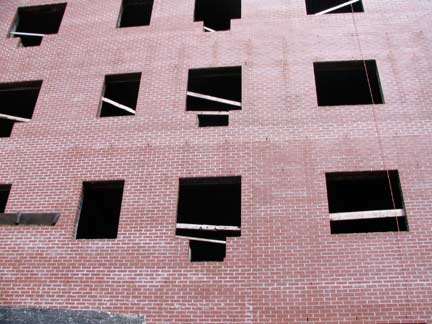
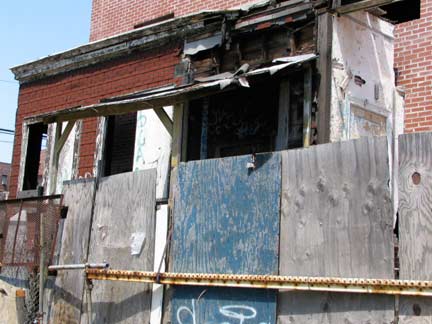


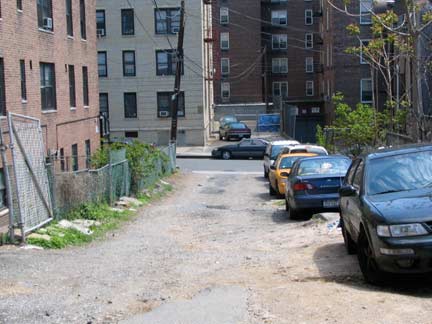
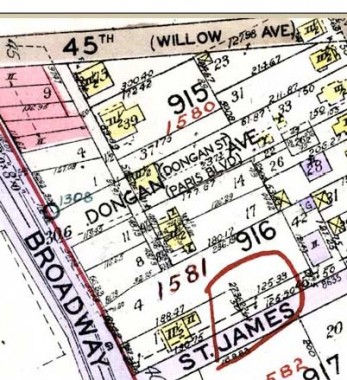
10 comments
I love this stuff about old Queens
I passed this hose @ Clarmont so many times>
My Dad who died last year @ 91 had many memories ,raised on 10 acres @ 91 pklace near Asorian Blvd,.His family held feats there.
Told me many stories about North beach and Holms field,Trains Meadow RD.,A creek that existed nrar the entrance@ 94th Street by the airport,The old mansions where the GCP ( with docks for boats),and the swamps in the east elmhurst/ jackson ares,etc. .
lived at 1 claremont terrace in the early 60’s. went to newtown h.s. i believe rose rella owned the home then. always felt creepy like it was haunted…sorry to see the state it became. it must have been very grand.
I grew up at 1 Claremont Terrace 1949-1964. My grandfather bought the property in the 1920’s and when he passed in 1957, his remaining 5 children inherited, my father and his 4 siblings. By the early 1970’s, Aunt Rose was the remaining owner. I have so many happy memories of growing up there, the house was already a hundred years old , turned into 5 apartments, but the old grandeur was still apparent, the moldings, the curved wooden bannister leading upstairs ( which we used to slide down), the crystal chandelier in what was the old ballroom, the bricked in old fireplaces which still had their mantelpieces, the servants quarters, etc. It was such a shame what became of the old place. I guess it wasn’t historical enough to be preserved according to the city. If you ever find any old photos of it’s glory days, please let me know. Thanks, Diane Rella Monroe
I lived at 1 Clermont terr in 1964 ans 1065. my family and I lived on thr lower level fpr 2 years.
when I thnk about it it was a really beautiful house.
Rose rella owned the house than, and her sister and her husband lived in a room on the main floor.
it was creepy because I remember an old main lived upstairs but nobody ever saw him.
we moved in 1966 I think.we lived there during the black out.
My late wife, Maureen Tandy, spoke of you often. She lived at Claremont Terrace with her parents. She later lived on Dongan Ave when I knew her. That would have been around 1963. I believe they lived on the top floor and had a beloved neighbor, Mrs. Rausche.
On the first 1891 map, you will see Samuel Lord’s neighbor, across Broadway was Mrs. Perry. (Lord may have also bought the corner next to her from the family; the estate may have originally included the one listed as Andrews as well.) Mrs. Perry’s maiden name was Moore; that Perry land was the last of the old Moore estate, which she inherited. She was a descendant of Rev. John Moore of Newtown, the 1652 first pastor at the Puritan type church that became The First Presbyterian Church of Newtown. (It turned Presbyterian in 1715- 300 years ago) The property was given to Moore’s young sons by the town upon his death at a early age, along with a house (small center section of the bldg. you see in photos of the house). The town was grateful to him for his help in buying western Queens from the Indians (all land west of the Flushing River, south to Brooklyn. It later became known as Newtown.) The ancient Moore house, and some of the land remained in the family until Mrs. Perry’s husband came into the picture. I believe his name was Oliver Perry, related to Commodore Oliver Hazard Perry. I think their gravestone is outside the current St. James Church. (Her branch of the Moores turned Episcopal). He was a city boy and found Newtown too countrified and boring for his taste and kept urging her to sell the property. She loved the old 1600s home & later additions, and held out as long as possible. The city bought up her property, part of which is now Moore playground. The ancient house was destroyed so that a turn could be put in for the subway. “Progress”, at whatever the historical loss, is the story of the old town of Newtown. That trend sadly still continues.. I am the historian of The First Presbyterian Church of Newtown whose first pastor was Rev. John Moore.
I have been living in Oakleigh in Sale, Cheshire, UK for 45 years (2018). This was the house that Samuel Lord retired to. The house is also very large and grand though there have been many changes over the years and has been flats for some considerable time. I am wanting to put together a Facebook page for Oakleigh and Samuel Lord but need first to get clarification of the history of the building and Samuel Lord and his family from our local historian Michael Riley. For all who may be interested, please look out for the Facebook page (not complete at this date Jan 2018) and once up and running, feel free to join the page as I will try to put this link on. Approximately, 18 months ago, Samuel Lord’s grand daughter (who is American) came to Oakleigh with her mother in order to have a look around. Samuel Lord has a family grave and monument 5 minutes from Oakleigh which I often visit. I wish to try to reserve some history of this great man in one place if possible, so your stories would be most welcome.
HI – is your page on Oakleigh and S. Lord up on Facebook currently ? Have you been able to learn more about Sam Lord?
I grew up on St James Ave, I remember people living in the surviving mansion (in fact I know an acquaintance that lived there shortly). In the ’80 and through the ’90s, the house was a multi family rental. We knew the inner didn’t live there. I think the house failed to get a CO around 2000 and was boarded. I don’t ever remember the house being in good condition and got worse over the years. We called the Claremont area the Hill. I have fond memories of that place. Thanks for posting the article.
i think of the history here everytime i pass near along Broadway or Whitney. Future readers with an interest can learn more of Newtown’s history in Vincent Seyfried’s research on Elmhurst, available freely online through local library’s digital collection.